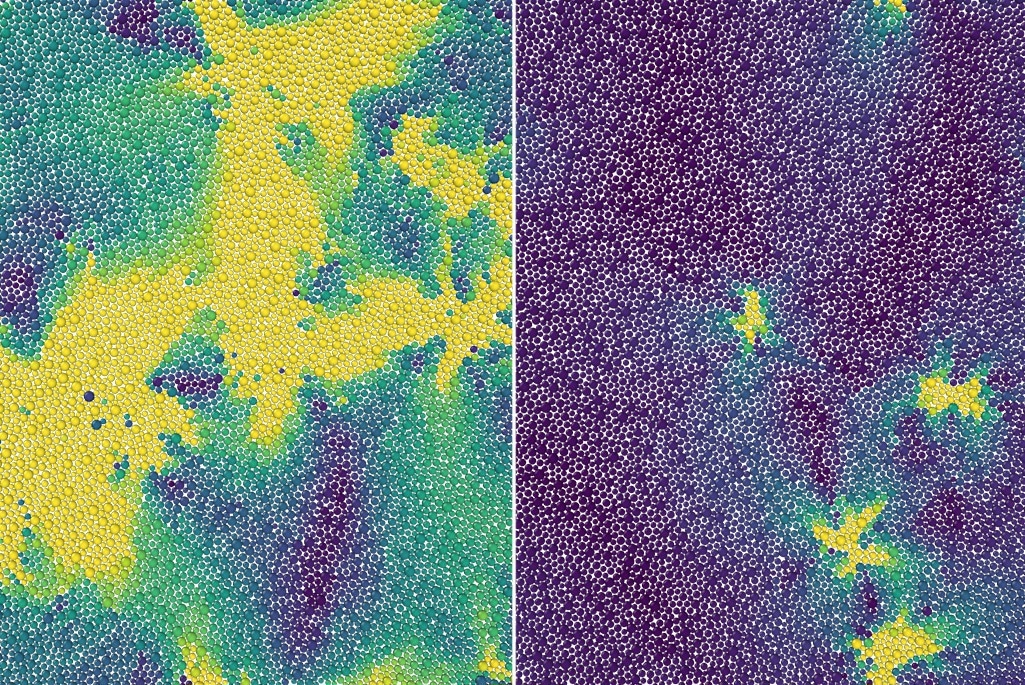An amorphous material is anything made of plastic or glass. When cooled, the atoms and molecules in amorphous materials never assemble to form crystals, unlike many other materials that freeze into crystalline solids.
 (Left) Above an onset temperature, a 2D material exhibits normal liquid behavior with all particles similarly mobile (yellow). (Right) Below that temperature, it becomes supercooled, with the onset of rigidity leading to just some mobile particles (yellow) amongst solid-like ‘frozen’ regions (blue). Image Credit: Kranthi Mandadapu
(Left) Above an onset temperature, a 2D material exhibits normal liquid behavior with all particles similarly mobile (yellow). (Right) Below that temperature, it becomes supercooled, with the onset of rigidity leading to just some mobile particles (yellow) amongst solid-like ‘frozen’ regions (blue). Image Credit: Kranthi Mandadapu
While researchers commonly refer to plastic and glass as “solids,” they are more adequately defined as supercooled liquid that flows exceptionally slowly. Although these “glassy dynamic” materials are part and parcel of everyday lives, scientists have long been puzzled about how they become rigid at the microscopic scale.
Investigators at the Lawrence Berkeley National Laboratory (Berkeley Lab) of the Department of Energy have revealed molecular behavior in supercooled liquids that reflects a hidden phase transition between a liquid and a solid.
Their immense knowledge relates to common materials like plastic and glass. It could aid researchers in creating new amorphous materials for additive manufacturing, medical devices, and drug delivery.
The researchers explicitly explained why the molecules in these materials, when cooled, stay disordered like a liquid until taking a quick turn toward a solid-like state at a specific temperature known as the onset temperature—efficaciously becoming so viscous that they barely move. This phase transition, the onset of rigidity, distinguishes supercooled liquids from ordinary liquids.
Our theory predicts the onset temperature measured in model systems and explains why the behavior of supercooled liquids around that temperature is reminiscent of solids even though their structure is the same as that of the liquid.
Kranthi Mandadapu, Staff Scientist, Chemical Sciences Division, Lawrence Berkeley National Laboratory
Kranthi Mandadapu is also a Professor of Chemical Engineering at the University of California, Berkeley, who guided the research. The study was published in the journal PNAS.
Any supercooled liquid alternates between various molecular configurations continuously, causing localized particle movements called excitations. The excitations in a 2D supercooled liquid were regarded as defects in a crystalline solid in Mandadapu, Postdoctoral Researcher Dimitrios Fraggedakis, and Graduate Student Muhammad Hasyim’s proposed theory.
They suggest that every instance of a bound pair of defects split apart into an unbounded pair as the temperature of the supercooled liquid rose to the onset temperature. The system lost its rigidity and started to behave like a normal liquid at precisely this temperature due to the unbinding of defects.
The onset temperature for glassy dynamics is like a melting temperature that ‘melts’ a supercooled liquid into a liquid. This should be relevant for all supercooled liquids or glassy systems.
Kranthi Mandadapu, Staff Scientist, Chemical Sciences Division, Lawrence Berkeley National Laboratory
Other key features of glassy dynamics were also captured by theory and simulations, such as the finding that only a small fraction of the liquid's particles moved over brief time intervals while the majority remained frozen.
“The whole quest is to understand microscopically what separates the supercooled liquid and a high temperature liquid,” added Mandadapu.
Mandadapu and his coworkers believe their model can be extended to 3D systems. They also intend to broaden it to explain how localized motions cause additional nearby excitations, which relax the entire liquid. These components, when combined, could provide a consistent microscopic picture of how glassy dynamics unfold in a way that matches current observations.
It’s fascinating from a basic science point of view to examine why these supercooled liquids exhibit remarkably different dynamics than the regular liquids that we know.”
Kranthi Mandadapu, Staff Scientist, Chemical Sciences Division, Lawrence Berkeley National Laboratory
The Department of Energy’s Office of Science financially supported the study.
Journal Reference:
Fraggedakis, D., et al. (2023). Inherent-state melting and the onset of glassy dynamics in two-dimensional supercooled liquids. Proceedings of the National Academy of Sciences of the United States of America. doi.org/10.1073/pnas.2209144120.